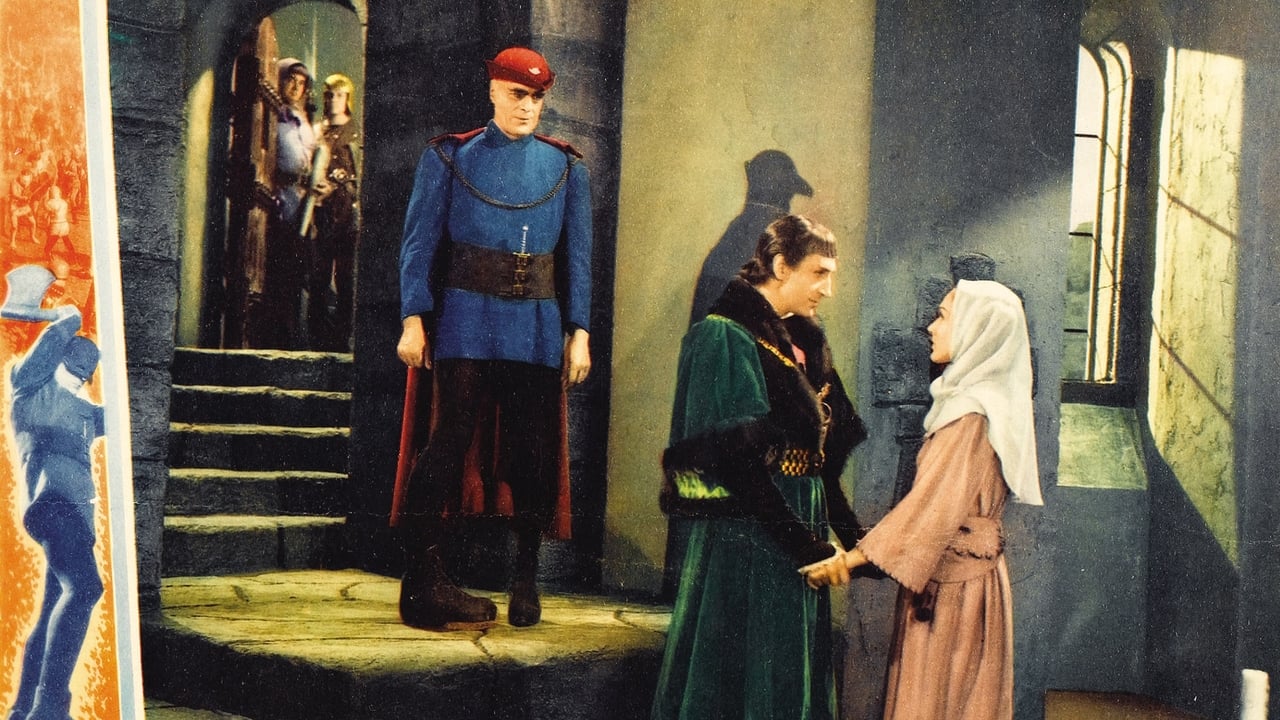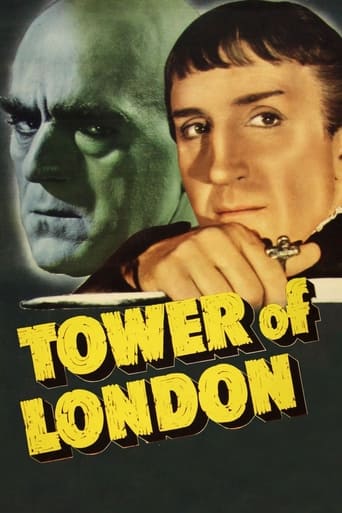InformationRap
This is one of the few movies I've ever seen where the whole audience broke into spontaneous, loud applause a third of the way in.
filippaberry84
I think this is a new genre that they're all sort of working their way through it and haven't got all the kinks worked out yet but it's a genre that works for me.
Philippa
All of these films share one commonality, that being a kind of emotional center that humanizes a cast of monsters.
Scotty Burke
It is interesting even when nothing much happens, which is for most of its 3-hour running time. Read full review
JohnHowardReid
This lavish historical spectacle moves like a cavalry charge down a steep hill until about halfway through. Oddly enough, the point at which the action starts to slow down is when Edward IV dies. As Edward is played by that normally stodgy actor, Ian Hunter, one would have thought that his death would make little difference. But Hunter is a great deal more animated than usual in "Tower of London". Not only does he play his lines with force and credibility, but he portrays Edward as a scoundrel who is as lively and charismatic as he is unscrupulous and dastardly. Rathbone, on the other hand, who is cast in the seemingly more meatier role of Richard, plays it rather cool and deadly, with little animation. He comes to life only in his dueling sequences which he carries off with his usual flair. Karloff, rather strikingly made up with his bald head, twisted leg and club foot, is a more interesting presence.At its best, the film ranks as a must-see movie. The battle sequences (especially the initial conflict in the rain) and the set pieces (like the execution) are most vividly directed and staged. Great sets and superb cinematography add significantly to the film's appeal. The only technical letdown is provided by the rather pedestrian music score.
Leofwine_draca
This slow-moving piece benefits from a very effective performances by star Basil Rathbone as a corrupt duke whose ambitious nature leads him to gradually destroy all those who stand between him and the crown. Rathbone exudes cunning evil in this enduring film, and his scheming and wicked ways are the chief reason to watch. Not many other actors could have done this better. Although Rathbone is best known for his role in over a dozen Sherlock Holmes films in the 1940s, this remains one of his best performances ever.Some people have complained that this melodrama is too slow, not in my opinion. I think a lot of people are simply disappointed that this isn't exactly a horror film after it was recently re-released in misleading packaging. Sure, it's not horror, but there are plenty of frightening moments (plus the usual torture, beheadings, sword fights, you name it...), and Boris Karloff stumps around in makeup which wouldn't look out of place in any spooker you care to mention. Karloff here adopts the role of a faithful manservant to Rathbone, a bald executioner with a club foot who carries out his master's bidding unnervingly. Karloff isn't given much opportunity to act here, apart from in a scene with a young child, and mainly trades in on his terrible Frankenstein image. But then there's no harm in that.The time period of the film is very good, as we gradually watch Rathbone rise through the various ranks in the royal court. Absolutely nobody stands in his way in the film until the final moments where a heroic opponent escapes and paves the way for a full-scale battle. The acting is uniformly good, as is the score, and it's nice to see a young Vincent Price in an amusing role as a drunkard who meets his end in a vat of red wine. Price sports a terrible British accent here and plays a very effeminate character, but his portrayal of drunkenness is accurate and you can see the seeds which eventually led to him becoming a famed actor some two decades later in the likes of THE MASQUE OF THE RED DEATH.As for the horror content, there are a few choice moments in a torture chamber to delight the genre fan. Karloff is a master of pain, casually tossing water over a floor for a prisoner to lick up and dropping a weight on a man's chest in passing. I was surprised how graphic some of these tortures were, and one man has to survive whipping, branding, and even being stretched on the rack at the end of the film. Some battering! If you want to see a Shakespeare play given a top-notch treatment by some forgotten stars, then TOWER OF London is the film for you.
dougdoepke
All in all, this oddball 90-minutes could be called a noir costume drama. The lighting is either dull gray, shadowy b&w, or plain foggy, all the way through. Of course, this befits a very dour tale based, it seems, on some historical fact. As the scheming Richard of Gloucester, the sharp-featured Rathbone is perfect. And by golly, nothing's going to stand in the way of his becoming a 15th century King of England, even if he has to step on half his family to get there. Of course, he's got reliable old clubfoot Mord (Karloff) to do the dirty work. And do it, he does.It's impressive how well Rathbone transitions here from the unscrupulous plotter to his later intellectual gumshoe Sherlock Holmes. There's been no one quite so compelling before or since. Then too, as Mord, the great Karloff makes better use of his massive frame than usual. With his bald head (though the skull cap seams sometimes show), he's an incomparable presence. Still, there's that fleeting moment where the murderous Mord contemplates the sleeping bodies of the two doomed princes and the cruelty of his work. It passes quickly but amounts to a telling touch. Then there's that memorable scene where the Duke of Clarence (Price) and Richard compete for most quaffed wine in royal history; that is, before Clarence gets to bathe in the vat permanently. Though I've never again heard of Malmsey kind of wine, that scene's stayed with me for years.In my little book, director Lee is underrated for his work here and in other costume epics he seems to have specialized in, e.g. Captain Kidd (1945). Nonetheless, the movie is flawed in certain respects, as other reviewers point out. There's a heckuva lot of characters that come and go, so you may need the proverbial scorecard. Plus, the royalty gets their finery to wear, but the bare-bones interiors look like the budget didn't cover set decoration. And I'm still wondering how combatants could tell friend from foe in those fog shrouded battle scenes that come across like cloudy nightmares.Anyhow, I know nothing about the historical accuracy of what's on screen. Nonetheless, the oddball results have stayed with me for near 6-decades. Thanks, Rathbone and Karloff, and especially a long-gone TV Late Show.
Mart Sander
As this film premiered a mere week after The Private Lives of Elizabeth and Essex, I can't help but think how the viewers compared the two historical spectacles. In this case Universal comes in second (as might be the case when you compete against Warner Bros) even though The Tower of London is great fun to watch. The ensemble of the male actors is perfect: Karloff, Rathbone and Price at one go means a good show. They look great and are well fit for historical parts. The ladies are, nevertheless, hideous. They are required to wear unidentified period costumes with weird wigs and head-gears combined with very thirties make-up which make them appear as some kind of crossbreeds between Isolde and Mickey Mouse. Perhaps the smell of mediocre production values could have been suffocated by the use of color photography, but alas, the b/w images never take off as they should. The film still moves along effortlessly and if you can look past the obvious thirties liberties taken with the subject and artwork - or indeed, if you enjoy these - then the film is a plate of definite dessert.

